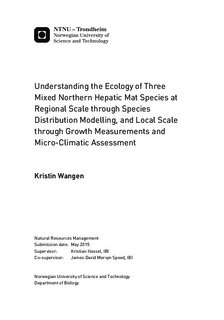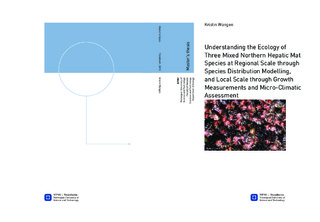| dc.description.abstract | Good knowledge of a species' distribution and ecology is important for a successful management. The distribution of species is determined by many factors, among others climatic and topographic factors determining their potential distribution. Other factors such as dispersal mode further affects their actual distribution through the ability to disperse and establish in suitable habitats. In this thesis, the ecology of three species belonging to the nationally and globally rare mixed northern hepatic mat community is assessed in two separate studies, at a regional scale through species distribution modelling (SDM), and at a local scale Scapania nimbosa Taylor through micro-climatic comparison of presence and absence sites in addition to growth measurements. The results from the second study indicate that S. nimbosa grows approximately 4.68±2.25 mm during one growth season, although this is probably an under estimate, and the variation between shoots is very large. In the fist study, the SDM for both Anastrophyllum donnianum (Hook.) Steph., Scapania ornithopodioides (With.) Waddell and S. nimbosa predicted highly suitable areas outside the known geographical range at the south-western Norwegian coast, although the model for S. nimbosa could not be interpreted with confidence. It was not possible to find any difference in micro-climate between presence and absence sites for S. nimbosa. These results indicate that all three species are limited by dispersal rather than habitat in Norway, with suitable absence sites both at a regional scale for all three species, and also at a local scale for S. nimbosa. Anastrophyllum donnianum seems to be limited from reaching highly suitable areas in northern Norway due to a barrier of unsuitable climate mainly due to insufficient summer rain. This area may become suitable if climate change leads to an increase in summer precipitation along the Norwegian coast. Scapania ornithopodioides is absent from northern Norway despite the presence of highly suitable habitats continuously scattered throughout large parts of the western coast. The results suggest that both A. donnianum and S. ornithopodioides prefer high rain frequency and high amount of summer rain, and medium summer temperatures at approximately 10 ͦ C. This is consistent with the current understanding of the ecology for these two species. Areas that stand out as interesting for the search of potentially undiscovered populations include northern Norway, the Fosen peninsula and the Lofoten Islands. Highly suitable areas may also be appropriate for tranlocation of turfs or plant fragments, with the aim at increasing the abundance and geographical range of threatened species. Other studies indicate that in situ regeneration from plant fragments of several mixed northern hepatic mat species is likely to be successful. This is especially relevant for the rare species S. nimbosa, which is vulnerable due to a presumably small geographical range in Norway which may be contracted in the face of climate change, and due to limited dispersal abilities. | |

